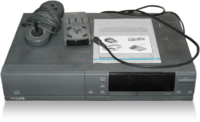From NintendoWiki, your source on Nintendo information. By fans, for fans.
Philips CD-i
|
|
|
| No. of games
|
|
| No. of launch titles
|
{{{launch_games}}}
|
| Best-selling game
|
{{{best_games}}}
|
| Last game
|
|
|
|
| Media
|
CD-i disc
|
| Storage capacity
|
1 MB RAM
|
| CPU
|
Philips SCC68070
|
| Model no.
|
{{{model}}}
|
|
| Can connect with
|
N/A
|
| Input
|
{{{input}}}
|
| Backwards compatible with
|
N/A
|
| Services provided
|
Multimedia player
|
|
| Launch date
|
- NA: December 3, 1991
- EU: 1992
|
| Discontinue date
|
1998
|
| Units sold
|
1 million
|
|
|
|
The Philips CD-i is a home multimedia device released in 1991 by Philips. Acting in some ways similar to a modern-day DVD player, the CD-i was supposed to represent a revolutionary new era for media players - a single device that could play not just music CDs but also video games.
The CD-i was the result of a failed deal between Nintendo and Sony to create a CD-based add-on for the SNES called the PlayStation Experimental. Sony, however, wanted a large share of the profit from this add-on, as well as the right to brand it with their logo. Without warning, Nintendo canceled the deal, moving to Sony's rival Philips to make the same add-on. Sony's research and development on the PlayStation Experimental led to the release of the PlayStation console in 1996 as a rival to the Nintendo 64.
When Nintendo eventually backed out of the deal with Philips, Philips demanded to use several of Nintendo's characters in games for the CD-i, leading to the notoriously poor Zelda: The Wand of Gamelon, Link: The Faces of Evil, Zelda's Adventure, and Hotel Mario.
Models
The Philips CD-i was released in a number of models by Phillips depending on the market:
- CD-i player 200 series: includes the CD-i 205, 210, and 220 models, marketed toward the general public.
- CD-i player 300 series: includes the CD-i 310, 350, 360, and 370 models, marketed for professional use.
- CD-i player 400 series: includes the CD-i 450, 470, and 490 models, slimmed-down units marketed toward the console and educational markets.
- CD-i player 900 series: includes the CD-i 601, 602, 604, 605, 615, 660, and 670 models, marketed toward professional software developers, not made available for the general market.
External links

|
This article is a stub. You can help NintendoWiki by expanding it.
|
|
|
|
|
|
|
| Other
|
| Standalone consoles
|
Arcade
|
Pokémon
|
Classics
|
Cancelled
|
|
|
|
|
|
|
|


